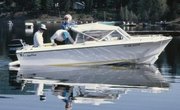
Sand and grit and dirt in the bottom of your boat can, over time, badly scratch and discolor the floor of your boat. Often you can spruce it up quickly with just a new layer of gelcoat. This won't repair major dents and chips or add much strength to the floor. The extra layer of gelcoat will also increase the weight of your boat a bit. All in all, however, gelcoating the floor of your boat is a nice, fairly easy spruce-up for an aging boat.
Items you will need
Gelcoat mix
Gelcoat color tints and chart
MEKP: catalyst
Stirring stick
Pint capacity mixing container
Acetone
Cleaning rags
Disposable 4-inch-wide brush
Orbital sander
Wet/dry sandpaper, 80- and 600-grit
Buffing compound
Buffer
Self-adhesive traction strips or water-resistant carpet
Step 1
Clean the floor or deck of the boat. Remove any old glued on carpet, dirt or debris by sanding if necessary. Scrub the floor thoroughly clean, then wipe it down with acetone.
Step 2
Rough the surface of the floor with an orbital sander and 80-grit sandpaper. This gives the gelcoat something to adhere to. Wipe the floor again with acetone and a rag and allow it to dry thoroughly. Wear gloves and eye protection at all times when handling acetone, gelcoat or catalyst.
Step 3
Mix together enough gelcoat to cover a 1- or 2-square-foot area at a time. Measure the suggested amount of color tint from the color chart so that the gel will match the color of the rest of the inside of the boat hull. Add color tint drop by drop according to manufacturer's directions.
Step 4
Add the MEKP catalyst according to manufacturer's instructions. Work quickly so the gelcoat doesn't set up before you get it applied to the boat. Be precise with the amount of catalyst, or the gelcoat could set too fast or too slow and spoil the finish.
Step 5
Paint the gelcoat onto a selected area. Work in overlapping squares, mixing enough gelcoat for one square at a time. Watch for air bubbles in the gelcoat and pop them with a sharp instrument like a nail or a knife point. Bubbles will leave pinholes in the finish where dirt and debris can collect.
Step 6
Work steadily until you finish the whole floor of the boat. Start early so you have time to finish it all in one day. As you work, the previous sections should not be hardened before you apply the gelcoat to the adjacent area. The gelcoat will harden in about four hours, but allow it to cure overnight before walking on it or buffing it.
Step 7
Wipe the floor of the boat with a rag and acetone to remove any tackiness. Lightly sand the floor with 600 grit wet/dry sandpaper and an orbital sander. Then apply buffing compound and buff the floor to bring it to a fine shine.
Step 8
Apply traction strips or carpet sections where solid footing is critical.
Warnings
- MEKP catalyst is caustic and can burn your eyes. Handle with care.
- Always wear gloves and eye protection when working with fiberglass chemicals and solvents.
References
Warnings
- MEKP catalyst is caustic and can burn your eyes. Handle with care.
- Always wear gloves and eye protection when working with fiberglass chemicals and solvents.
Writer Bio
Tom King published his first paid story in 1976. His book, "Going for the Green: An Insider's Guide to Raising Money With Charity Golf," was published in 2008. He received gold awards for screenwriting at the 1994 Worldfest Charleston and 1995 Worldfest Houston International Film Festivals. King holds a Bachelor of Arts in communications from Southwestern Adventist College.



